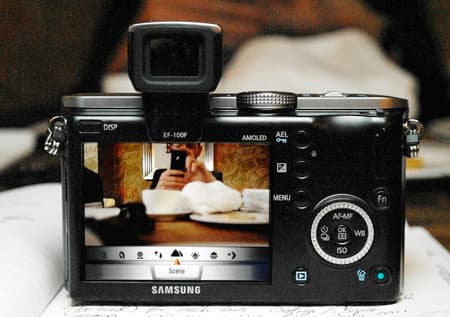Samsung NX100 review first impressions
I suppose the next logical step from the DSLR-shaped NX10 had to be the compact rangefinder-style of the Olympus Pen, the Panasonic GF1 and the Sony NEX bodies. And it seems a good move. Samsung’s NX10 has served well to demonstrate that the brand can make a serious-looking camera that performs well, and now is the right time to produce the more high street-friendly model that will perhaps grab a bit more attention. Not that the appeal will stop at the mass market as the rangefinder looks will also catch the eye of more dedicated photographers, and if Samsung ever actually gets a K-mount adapter into the country it will make a nice match for the chrome barrels of some of the limited edition Pentax optics.
At 120x71x34.5mm the Samsung NX100 seems to offer a greater space saving over the 123x87x39.8mm NX10 than it really will, but at 282g it is a more significant 71g lighter. In essence, though, we are looking at an NX10 in a different shaped body.
The new, and excellent, i-Funtion feature, that allows users to access and control the main modes of the camera via a lens-mounted button and the focusing ring, will hopefully be incorporated into the NX10 through a firmware update before the end of October.
The i-Funtion really seems to deliver a new level of handling, and rather than being just a gimmick it makes switching ISO, white balance, or scene modes, etc, something that can be done quickly and easily without having to take the camera away from the shooting position. It is the first time I’ve seen a camera that can be controlled by its lens. The i-Funtion button is pressed on the lens to activate the modes icons on the screen of the camera. Turning the focus dial scrolls through the modes that are available to be changed, while a second press of the i-Funtion button selects the mode you want to change, and the focus ring takes you through the options that mode offers.
 The new electronic viewfinder has a resolution of 300×224 pixels. Showing at the bottom of the LCD screen here is one of the menu bars that appears with the i-Function button is pressed on an enabled lens
The new electronic viewfinder has a resolution of 300×224 pixels. Showing at the bottom of the LCD screen here is one of the menu bars that appears with the i-Function button is pressed on an enabled lens
Of course, in common with the original Olympus Pen camera, the NX100 does not feature a built-in flash unit. This may put some users off, although Samsung has introduced the very small SEF-15A flash unit to mount in the camera’s hotshoe. Perhaps the only flashgun on the market to use AAA cells, this GN15m @ ISO 100 gun offers simple TTL or manual operation. It is a good deal smaller than the company’s SEF-20A, which retails for about £110, and while prices have yet to be released, it needs to be a good deal less money, if not thrown in as standard in the way that Sony does for its NEX customers.
At first sight, the Samsung NX100 seems a well-made and well-considered next step for Samsung’s world-domination ambitions. The camera’s design will appeal to a wide audience (a white version is available abroad and may at some point come to the UK) and the controls and features on offer will please beginners and enthusiasts alike. The i-Funtion is a genuinely useful innovation, but the lack of a built-in flash might prove a sticking point for some buyers.
 This graphic demonstrates the extension of the new collapsible 20-50mm wide-angle zoom lens, from its locked position to fully extended
This graphic demonstrates the extension of the new collapsible 20-50mm wide-angle zoom lens, from its locked position to fully extended
Mounted on the NX100 the SEF-15A flash unit reaches out over the lens barrel
 Flash controls are limited to TTL and manual operation
Flash controls are limited to TTL and manual operation
 With no tilt or swivel action, and no additional diffuser, the SEF-15A is a basic unit, but one with more power than most built-in guns, even those on DSLRs, afford
With no tilt or swivel action, and no additional diffuser, the SEF-15A is a basic unit, but one with more power than most built-in guns, even those on DSLRs, afford









